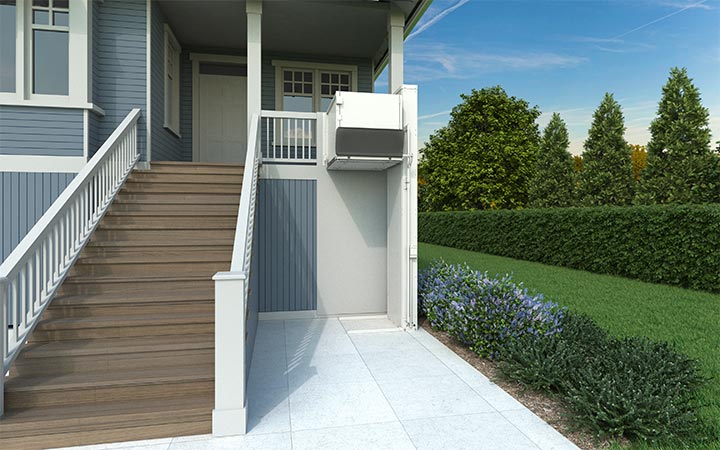
Platform Lift Basics
Platform Lifts allow people using mobility devices to easily enter or exit a home, deck or patio.
Read how our experts explain what a platform lift is, how they are commonly used, and the top considerations when purchasing a platform lift.
Platform Lift Basics | What is a Platform Lift?
Like a small elevator, a platform lift gives vertical access to people using scooters or wheelchairs. Platform lifts are commonly used to provide access between the ground level and a porch or deck, and are considered a space-efficient solution in comparison to a ramp.
By code, ramps need one foot of length for every one inch of rise. For example, a 12” rise would require a 12-ft ramp, or a 24” rise would require a 24-ft ramp. The long “runway” ramp system can be both unsightly and expensive. Platform Lifts are also considerably more cost-efficient than a residential elevator.
Bruno platform lifts feature a 750lb lift capacity and are available in heights up to 14 feet. Every VPL includes the core components of a tower, a platform and a landing gate to protect the top landing.
Platform Lift Basics | How Does a Platform Lift Work?
Operating a platform lift is easy. Just roll onto the platform and the lift will smoothly and quietly move to the next level with the push of a button. As the lift rises, the ramp automatically folds to create a safety barrier to stop a mobility device from unintentionally rolling off the platform. An optional platform gate is also available for an additional layer of safety.
Once the platform lift reaches the top landing, just push open the top gate on the platform lift and exit. To travel back down, reverse the process.
Bruno offers residential wheelchair lifts with different platform sizes, exits available on multiple levels and a variety of other options. Call your local factory-trained Bruno dealer today to learn more about how a platform lift can serve as a “mini-elevator” to help make your home more accessible. Bruno also manufacturers commercial platform lifts for schools, churches and other public buildings.
Platform Lift Basics | Top Considerations
Ensure that any platform lift you put in your home has standard safety features:
- Barrier to protect mobility device from rolling backward. When a user of a Bruno platform lift rolls onto the platform and presses the button to engage the lift, the ramp will automatically fold up to create a safety barrier to stop the mobility device from rolling backward. Gain an additional layer of security with the addition of an optional platform gate.
- Gate/door at top landing to prevent falls from top. At the top landing, there should always be a landing gate or door to prevent someone from falling from the landing when the lift is in the lowered position.
- Obstruction safety sensors to identify crushing hazards. An obstruction safety sensor located under the platform of a platform lift gently stops if it encounters an object. This is vital to avoid crushing any object that may get under the platform when the lift is in the raised position.
Platform Lift Basics | How is a Platform Lift Installed
Although a residential vertical platform lift (VPL) is a freestanding piece of equipment, site preparation may be needed before the installation process can begin.
- A platform lift must rest on concrete, so a concrete pad may need to be poured. In addition, a sidewalk may need to be added to create an appropriate “approach” path.
- A safety barrier gate is a core feature at the top landing of any vertical platform lift. Depending on the location, work may be needed to the surrounding area to allow for placement of the safety gate.
- You will also need electricity available nearby that will either power the lift itself or the battery charger.
- Most platform lift site preparation is minor. However, if the wheelchair lift is being used to access a basement or second story of your home, it will often be enclosed in what is called a “hoistway or shaftway,” which is like an elevator shaft.
Platform Lift Basics | How is a Platform Lift Powered
There are two ways in which a platform lift (VPL) can be powered: household current (AC) or battery power (DC).
- The most common method of providing power to your home platform lift (also known as a porch lift) is via a standard household outlet. Since you never have to worry about replacing batteries in the future, it results in an inexpensive method for total cost of ownership.
- Battery-powered platform lifts are considered a safer and more reliable solution since the lift will operate even if power is disrupted. Under normal use and circumstances, the platform lift batteries will last for several days after the loss of power. While factors such as frequency of use, weight lifted, height traveled and environment/climate can impact battery life, platform lift batteries will generally last several years. With a battery powered platform lift for your home, you have a high level of safety and security.

